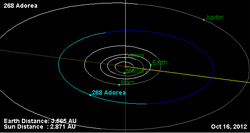Astronomy:268 Adorea
 Orbital diagram | |
| Discovery | |
|---|---|
| Discovered by | A. Borrelly |
| Discovery date | 8 June 1887 |
| Designations | |
| (268) Adorea | |
| Pronunciation | /əˈdɔːriə/ |
| Named after | adorea liba (spelt cakes) |
| A887 LA | |
| Minor planet category | Main belt (Themis) |
| Adjectives | Adorean /əˈdɔːriən/ |
| Orbital characteristics[1] | |
| Epoch 31 July 2016 (JD 2457600.5) | |
| Uncertainty parameter 0 | |
| Observation arc | 39,920 d (109.3 yr) |
| |{{{apsis}}}|helion}} | 3.515 astronomical unit|AU (525.8 Gm) |
| |{{{apsis}}}|helion}} | 2.668 AU (399.2 Gm) |
| 3.092 AU (462.5 Gm) | |
| Eccentricity | 0.13689 |
| Orbital period | 5.44 yr (1,985.5 d) |
| Mean anomaly | 302.257° |
| Mean motion | 0° 10m 52.748s / day |
| Inclination | 2.44010° |
| Longitude of ascending node | 120.914° |
| 69.5742° | |
| Physical characteristics | |
| Dimensions | 139.89±5.2 km[1] 140.31±3.34 km[2] |
| Mass | (3.25±2.26)×1018 kg[2] |
| Mean density | 2.24±1.56 g/cm3[2] |
| Rotation period | 7.80 h (0.325 d) |
| Geometric albedo | 0.0440±0.003 |
| FC | |
| Absolute magnitude (H) | 8.28 |
268 Adorea is a very large main belt asteroid, about 140 km in width.[2] It was discovered by A. Borrelly on 8 June 1887 in Marseilles. This asteroid is a member of the Themis family[3] and is classified as a primitive carbonaceous F-type/C-type asteroid. It is orbiting the Sun at a distance of 3.09 astronomical unit|AU with an orbital eccentricity (ovalness) of 0.14 and a period of 5.44 yr. The orbital plane is tilted at an angle of 2.44° to the plane of the ecliptic.[1]
From February 23 until March 2, 2006, photometric measurements were taken of the asteroid. These were used to produce a light curve showing a rotation period of 7.80±0.02 h with a brightness variation of 0.16±0.03 in magnitude. This result is consistent with some, but not all previous results. Some studies had suggested a longer rotation period of 15.959 h; double the time measured. However, the new data is inconsistent with the longer period.[4]
In May 1979, 268 Adorea was positioned in proximity of the galaxy NGC 4517 and as a bright new light source it was identified as a potential supernova. However, the light was missing from a second photographic plate taken ten days later, and the source was soon identified as the asteroid.[5]
The name refers to adorea liba, the Latin name for spelt cakes produced from meal and salt offered by the Romans as a sacrifice; the name was controversial among astronomers, as all previous asteroids had been named for humans or mythological figures.[6][7]
References
- ↑ 1.0 1.1 1.2 "268 Adorea". JPL Small-Body Database. NASA/Jet Propulsion Laboratory. https://ssd.jpl.nasa.gov/sbdb.cgi?sstr=268;cad=1.
- ↑ 2.0 2.1 2.2 2.3 Carry, B. (December 2012), "Density of asteroids", Planetary and Space Science 73: 98–118, doi:10.1016/j.pss.2012.03.009, Bibcode: 2012P&SS...73...98C. See Table 1.
- ↑ Florczak, M. et al. (February 1999). "A spectroscopic study of the THEMIS family". Astronomy and Astrophysics Supplement 134 (3): 463–471. doi:10.1051/aas:1999150. Bibcode: 1999A&AS..134..463F.
- ↑ Stephens, Robert D. (December 2006). "Asteroid lightcurve photometry from Santana and GMARS observatories - winter and spring 2006". Bulletin of the Minor Planets Section of the Association of Lunar and Planetary Observers 33 (4): 100–101. Bibcode: 2006MPBu...33..100S.
- ↑ West, R. (September 1979). "The Supernova that Was'nt - 268 Adorea". The Messenger (18): 14. Bibcode: 1979Msngr..18...14W.
- ↑ Schmadel, Lutz (5 August 2003). Dictionary of Minor Planet Names. Springer Science & Business Media. ISBN 9783540002383. https://books.google.com/books?id=VoJ5nUyIzCsC&q=adorea&pg=PA36.
- ↑ "268 Adorea". http://markandrewholmes.com/adorea.html.
External links
- The Asteroid Orbital Elements Database
- Minor Planet Discovery Circumstances
- Asteroid Lightcurve Data File
- 268 Adorea at AstDyS-2, Asteroids—Dynamic Site
- 268 Adorea at the JPL Small-Body Database
 |

